

25 Meaningful Second Grade Math Games Your Students Will Love. By second grade, kids are working to master basic concepts as they prepare for bigger challenges like multiplication and fractions down the line.
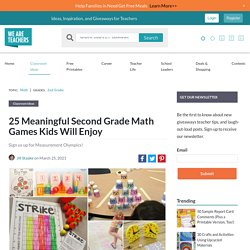
These second grade math games teach skills like skip counting, measuring and graphing, and working with money and time, all part of the Common Core standards. Plus, they’re lots of fun! 1. Twitter. Making Sense of Story Problems - IM CERTIFIED BLOG. By Deborah Peart, Grade 2 Lead Many people have an aversion to word problems.
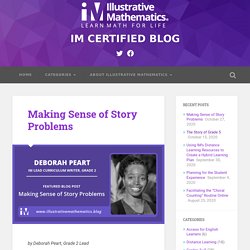
They cringe at the mention of them. In elementary classrooms, teachers often report that this is what their students struggle with most. When word problems show up in math class, even students who enjoy reading will release a sigh and let their shoulders droop. “Do words even belong in math class?” For the first 20 years of my teaching career, my expertise was in literacy: phonics, word study, and reading comprehension. For the past decade, I have immersed myself in the study of elementary mathematics. How can we support “sense-making” of stories in math class? The mission of Illustrative Mathematics is to create a world where learners know, use, and enjoy mathematics.
Provide Relevant Contexts During the process of writing this curriculum, the K–5 team had many conversations inspired by articles and books that we had read on the topic of culturally relevant pedagogy and practices. Twitter. Do You Have Enough Money? If you think others need to see this, share it on one of the sites below by clicking on the button.

Download Lesson Files You want to use the money you’ve collected in your coin bank to buy the game pictured above. How do you know if you have enough money in your coin bank to buy the game? If there is extra money, how much extra do you have? If there is not enough money, how much more do you need? This is a good opportunity to ask students, “How much money is in the bowl?”
They should realize that this view is more helpful than viewing the money in the bowl, however the money is difficult to count when it’s disorganized. Recording Addition on a Hundred Chart. I love having a theme and focus!
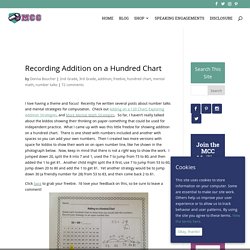
Recently I’ve written several posts about number talks and mental strategies for computation. Check out Adding on a 120 Chart, Exploring Addition Strategies, and More Mental Math Strategies. So far, I haven’t really talked about the kiddos showing their thinking on paper–something that could be used for independent practice. "I Like This Game Because You Have to Think Hard." A Monday afternoon, working with one of my second graders, helping him fill in a blank hundreds grid.
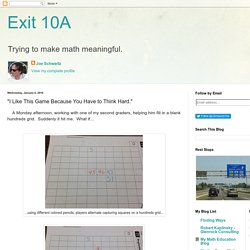
Suddenly it hit me. Bigger Bottom? Last week I had my first private tutoring session with an adorable 3rd grade boy.

You should know that I’m not a real structured tutor–I kinda like to find a starting point and just dive in. My questions and the tutee’s answers guide our path. The starting point for my young friend was subtraction with regrouping. I gave him the problem 53 – 16 to solve. Does anyone already have a visual video of the "constant difference" subtraction strategy? @BerkeleyEverett ? #iteachmath #mtbos… "Can you add the humps you see? Don't just count them one, two, three. To help you find the right amount, group in fives before you count!
Thank you @gregtangmath for the idea to have my students notice 1 compared to 10, compared to 100, compared to 1,000. Such a better visual than the cube. @RuckerRocks… I was AMAZED at how quickly my students could “shift” numbers to make them easier to subtract! This strategy is □! Thanks @gregtangmath! #leadthewaylf… Most Misunderstood Math Standards in Grade 2. When I was asked to expand the series on the Most Misunderstood Standards to grades K, 1, and 2, I jumped at the opportunity.

Teaching for Deep Understanding. Coins - Add to 20 (2-3 Addends) Coins - Add to 10 (2-3 Addends) Numberless word problems and bar models for Multi-Step word problems (CCSS 2.OA.1) Saturday, March 23, 2019 Numberless word problems and bar models for Multi-Step word problems (CCSS 2.OA.1) It's been a while since I've had the chance to blog, but I miss it so much that I'm making my return.
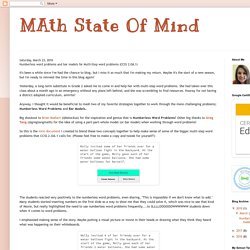
Maybe it's the start of a new season, but I'm ready to reinvest the time in this blog again! Yesterday, a long-term substitute in Grade 2 asked me to come in and help her with multi-step word problems. She had taken over this class about a month ago in an emergency without any plans left behind, and she was scrambling to find resources. The students reacted very positively to the numberless word problems, even sharing, "This is impossible if we don't know what to add.
" As the numbers were revealed, they wanted to start doing some/any kind math, but since we didn't know the full story yet, they weren't quite sure what operation to use yet. Posted by Jen Hudak at 5:10 AM Email ThisBlogThis! No comments: Post a Comment. Visuals Make EVERYTHING Clear. Grade 2 Comprehensive Math Talks Bank. Why I Like Using Open Number Lines...
This post was originally published on Marilyn Burns’ Math Blog.

When I visited Joe’s third-grade class, he was concerned about the results on his students’ homework from the day before. It was a computation practice assignment, and practically all of the children had either gotten the wrong answer to 503 – 398 or indicated that it was “too hard.” (Writing “too hard” was an option they had to let Joe know when they couldn’t figure out how to do a problem. This gave Joe useful feedback about what he needed to work on, either with the entire class or with specific students.) The problems on the homework assignment were all written vertically, so that students could apply the standard algorithms they were learning.